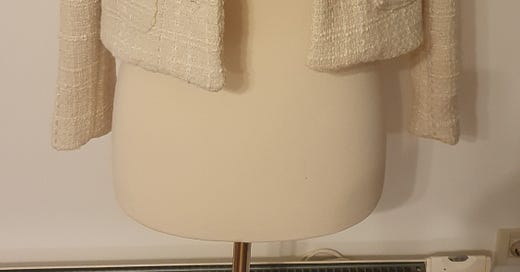Writing fiction is a lot like sewing.
The thought occurred to me while I was making a jacket for my mum. Her birthday was about a week away and I was keen to finish in time. Only, while checking the pattern pieces, I realised I’d traced them in two different sizes. So annoying when all you want to do is cut them out and sew them together.
Not so fast, I said to myself, eyeing two metres of bouclé by my side. It’s a delicate fabric that practically frays at the sight of scissors. It took me hours to prepare it by adding a thin layer of iron-on interfacing, which would keep it from falling apart. Alas, having done my fair share of mistakes, I’ve learned that slowing down in the initial stage to double-check the pattern can save both my time and the fabric. So, to do things at an optimal speed, I had to pause. That’s still completely incomprehensible to my ADHD brain, yet it has consistently worked out for my sewing and writing alike.
In sewing, slowing down might mean checking the pattern pieces, making sure I haven’t missed any markings. In writing, it might mean doing enough groundwork before starting a novel. And let me tell you, it takes A LOT of restraint to slow down and I have to constantly remind myself that I’m doing this to speed up the process.
A few months ago, I picked up an old story I’ve been trying to write for a decade. A decade of drafts and attempts to capture the story, some more structured than others: none had left me with a workable draft I could actually revise. As much as I loved getting down to it and writing the story as it unfolded, those drafts had ended in frustration and contempt for my writing and the story. It was a bit like being kicked out of your own game, sent back to the beginning and left to figure out the rules. Or like stitching together random scraps and trying to figure out what I’ve made.
So, this time, I took Jennie Nash’s Blueprint for a book, an incredible tool I use with my clients to lay the foundations for their novels. Unlike most other plotting methods, Blueprint explores your connection to the story on top of the story essentials. The closer I get to the story, the better I can understand and capture its shape in the early draft. It’s not unlike taking the time to cross-check a pattern before cutting into the fabric, although I will admit that making a garment is MUCH easier than writing a novel.
I sewed my mum’s jacket in a matter of days. A novel… I’d love nothing more than to pour that story out on the page and send it into the world right away, but I’ll have to let it trickle at its own pace, satisfied that it’s the right shape. And hey, who knows, I might have sewn an entire wardrobe by the time it’s finished.





lovely! Your message and finished jacket.